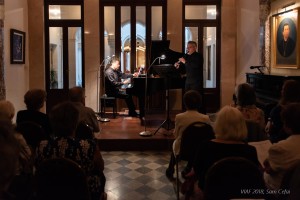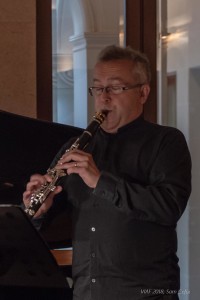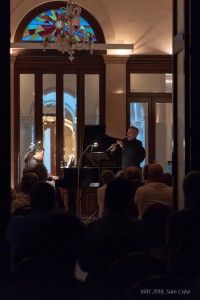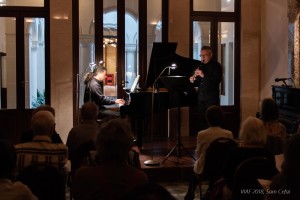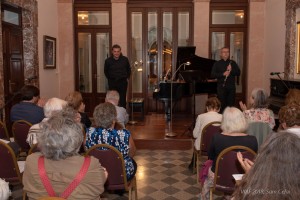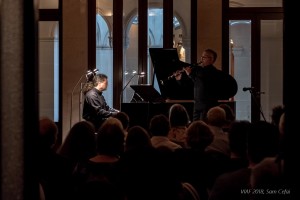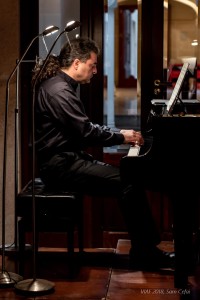Jože Kotar, accompanied by Luca Ferrini, dazzles
A much-awaited concert took place on Saturday 9 June, with world-class clarinettist Jože Kotar and pianist Luca Ferrini presenting a concert of the most demanding sonatas in the clarinet repertoire.
The recital started with Saint-Saëns’ Clarinet Sonataa beautiful work comprising four movements. From this point of view, it could be said that it reaches back past the Romantic sonata tradition, with its normal three-movement paradigm, to the Classical tradition that the composer loved so dearly. With the opening notes, the clarinettist established his unwavering authority, both musically and technically. His is a lush and sensuous tone, even across all registers. The opening melodic strains of the Allegretto first movement floated upon a sea of utterly calm eighth-note waves on the piano; the writing is staid and the unravelling of the themes takes place gently and unhurriedly. This was subtly understood by both performers who brilliantly captured the spirit of the work. That said, however, this movement simmered with passion aplenty as it developed, preparing the audience for the next section, an Allegro animato.
Very few instruments come close to emulating the seductive tones of a clarinet in its lower register, and Kotar had a field-day with Saint-Saëns’ slow movement, a Lento in the dark and seductive key of Eb minor; its steady half-notes and, in time, quarter-notes, were so persistent in their slow plodding that the audience could almost feel anguish at their inability to break free from the dirge they created. This was a beautifully wrought interpretation, balance was impeccably maintained with the piano not only providing firm accompaniment but also coming into its own when the occasion asked for it. Much happier was the Molto Allegro fourth movement that followed it without pause. Here, the clarinettist was given a chance to whirl and spin to some very florid virtuoso stuff, but at the end it was the quiet tone that prevailed over the tumultuous feelings unleashed with this movement.
Martinů’s style contains a neat blend of Dvořák’s good humour and melodic gift, Janácek’s terseness and fast musical action, and Stravinsky’s neo-classicism. This blend is well represented in the charming and extroverted Sonata for Clarinet and Pianoforte H356 which was next on the programme. The first movement is twice as long as either of the two others, but since it is divided into two clearly marked sections, the effect is a suite-like structure. The first movement, marked Moderato, was a test of rhythmic coordination, with complex cross rhythms between the different players’ parts. The second movement, an Andante, used the entire compass of the clarinet in a flowing melody. The third movement, a Poco Allegro, featured dazzling trills and other showy techniques. In a tricky effect to bring off, Martinů keeps the clarinet part an eighth-note ahead of the piano part in the counterpoint that dominated the music. This work was wonderfully executed not only technically but also musically and dynamically.
Leonard Bernstein needs no introduction, either as a composer or as a conductor. However, his Sonata for Clarinet and Pianoforte, an early work while he was still a student at the Curtis Institute is not as well known as his later works. That said, however, it fully manifests the supreme potential of this versatile American musician.
The first movement of his Sonata for Clarinet and Pianoforte, marked Grazioso, began with a slow, wandering clarinet theme over piano counterpoint, demonstrating the influence of Hindemith. Soon, the piano developed a fast, agitated ostinato rhythm over which the clarinet continued to spin out its theme. Bernstein splinters all of this into a brief development section; then, after a direct restatement of the opening slow material, the piano introduced a wistful, mildly bluesy melody soon picked up by the clarinet, the first passage that sounded more like mature Bernstein than mature Hindemith. This material meandered towards the movement’s final bar.
The second movement began with an Andantino, which again evoked Hindemith, mainly in the beautiful piano chords (which nevertheless hint very slightly at Bernstein’s song ‘Somewhere’ to come more than ten years later). Finally, lurching into the Vivace e leggiero section, Bernstein comes fully into his own. Kotar and Ferrini interpreted this movement assertively and with affirmation. It was strongly rhythmic and syncopated, but petered out halfway through the movement to be displaced by a slow, tender clarinet melody (the piano initially providing a busy, note-on-every-beat accompaniment but then breaking into widely spaced utterances of the two-chord ‘Somewhere’ motif). The fast, syncopated material returned, the piano’s ostinato pages giving the music even more urgency than before. At the end, Bernstein sends the clarinet to the top of its range in a sostenuto passage akin to the build-up to the finale of Copland’s Clarinet Concerto. A truly magnificent performance on all counts!
Horovitz’s Sonatina came next. This work is light-hearted and follows a traditional pattern of the three-movement division. The first, marked Allegro calmato, is in the classical sonata form, concentrating on the middle register of the clarinet. This was hauntingly executed by Kotar, with clear articulation and gentle weighting on each and every note without losing sight of the whole phrase. It came across as largely lyrical in mood and temperament, and moved against a rippling piano background. The second movement, a Lento, quasi andante, followed an A-B-A song structure employing some of the lowest notes of the wind instrument in a long cantilena over a slow chordal accompaniment. The finale is a kind of Rondo marked Con brio, and it alternated two themes in equal proportions, exploiting the upper register of the clarinet. The harmonic idiom of the whole work was obviously tonal, and it called for equal virtuosity from both players.
Jaka Pucihar is a contemporary Slovenian composer whose works have been performed in many venues all over his native country, as well as Austria, Italy, Germany, France, the USA, and Israel. His Sonata was the last item on a very eclectic and diverse programme, despite the fact that it consisted of Sonatas.
Sonata attests to Pucihar’s wide-ranging influences, from classicism to jazz rhythms. It incorporated many fascinating compositional elements including several from the jazz idiom. It also provided a significant cadenza for clarinet which was executed with driving excitement. It was interesting to note that the composer treated both instruments equally, and the result was a dialogue between two different voices that blended both rhythmically and melodically in an ever-engaging flow of musical discourse.
Throughout the recital Jože Kotar maintained an impeccable breath control which enabled him to produce the most minute and nuanced of dynamic shades. Luca Ferrini is a formidable accompanist whose understanding of and respect for the instrument he was accompanying was in evidence at every point.
The receptive audience were further regaled wit a delectable encore and the rapturous applause that greeted the last notes of this piece was more than merited!




